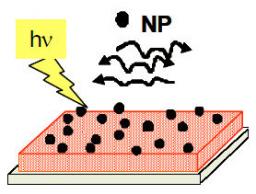
NanoSaclay LabEx - Fragship Nanophotonics : nano-objects for energy control
2012 - 2014
Partners :
- Laboratoire de nanophotonique, CEA / saclay (Fabrice Charra, coordinator)
- Equipe Nanosciences Moléculairss, ISMO U. Paris-Sud (Gérald Dujardin, board member)
- Laboratoire Photonique et Nanostructures, CNRS Marcoussis (Robert Kuszelewicz, board member)
- Laboratoire de photophysique et photochimie supramoléculaires et macromoléculaires, ENS Cachan (Keitaro Nakatani, board member, Anne Débarre)
- Laboratoire PMC, Cnrs - Ecole Polytechnique (Jacques Peretti)
- Laboratoire de Chimie Inorganique, ICMMO U. Paris Sud (Anne Bleuzen)
- groupe Nanophotonique et Electromagnétisme, Laboratoire Charles Fabry, IOGS (Jean-Jacques Greffet)
- Groupe Edifices Nanométriques, CEA / Saclay (Cécile Reynaud)
- Laboratoire de Chimie des Surfaces et Interfaces, CEA / Saclay (Serge Palacin)
The goal of our project is the noninvasive optical manipulation of nano-objects with ultimate sizes, down to the single molecule. To this aim, we propose to combine high optical confinement techniques with molecular-level mastering of the conversion of light energy into mechanical work, following an integrated multi-disciplinary approach involving optical physicists and surface organic chemists.
Two strategies will be employed:
Field-gradient enhancement. They will be obtained through optimization of specifically-designedplasmonic nano-structures. The opportunities offered by their combination with nonlinearly-responsive molecular architectures will also be explored.
Molecular motors. The surface of the nano-object will be functionalized with photo-isomerizing azo molecular moieties. Simultaneously, we will evaluate the potential of light-controlled forces on spin-transition molecular magnets. It will be followed by the analysis of the mechanical interactions with functionalized and/or nano-structured surfaces, as well as with bulk soft-matter environments.














